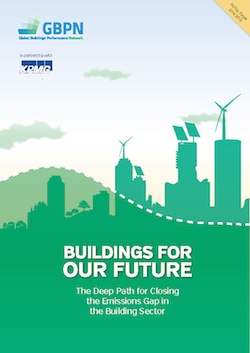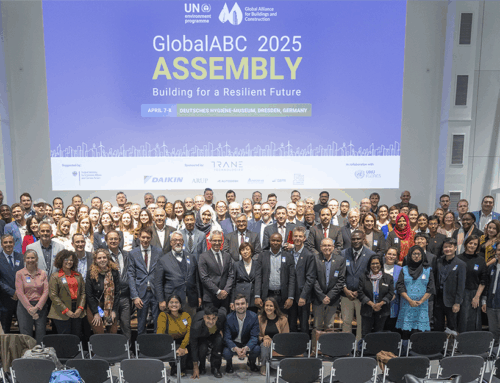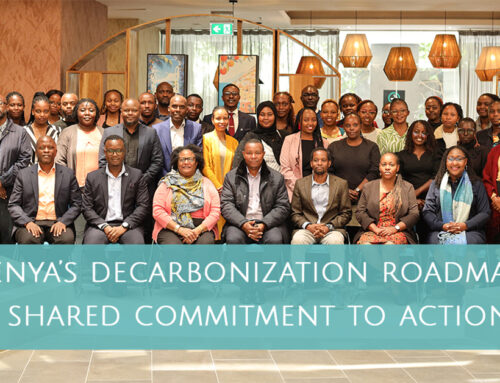[Report] Why Buildings Hold the Key To a Low-Carbon Future
SOUTH-EAST ASIASOUTH-EAST ASIA
New GBPN Policy Paper shows that implementing ambitious performance building policies can achieve deep reductions in energy consumption and CO2 emissions and sets out the necessary steps towards a “Deep market transformation”.
Buildings for our Future – The Deep Path for Closing the Emissions Gap in the Building Sector demonstrates that by 2050 it is possible to reduce building energy use by nearly a quarter of that of today and related CO2 emissions by one third by using today’s most advanced techniques and technologies. It will require widespread adoption of today’s state of the art policies and technologies including net-zero or positive energy requirements for new buildings and more and deeper energy efficient renovation of the existing building stock.
This report, developed in partnership with KPMG, brings together analysis commissioned by the GBPN over the past year, identifying the building sector’s mitigation potential in the GBPN’s four regions – China, Europe, India and the United States – together with a review and analysis of best practice policies that, if effectively applied globally, could pave the way to that transformation to the “Deep Path” to deliver the buildings sector’s mitigation potential. The report also raises concerns about risks of the “lock in” effect that could delay major energy savings and emissions reductions for decades if we do not act quickly.
Buildings for our Future sets out the necessary steps towards a “Deep” market transformation: First, define the “Deep Path” agenda by analysing the mitigation potential of buildings in a jurisdiction, and identifying the environmental, cost-benefits and co-benefits of applicable state-of-the art policy packages. Second, all stakeholders need to be engaged, involved and fully committed. Third, develop policy roadmaps adapted to each region to guide the implementation process. Fourth, implement a “Deep Path” agenda for the next decade. Finally, it is critical to ensure that all elements are well monitored, evaluated and adapted to ensure maximum effectiveness.
In Buildings for our Future, the GBPN has raised the challenge for countries to follow the “Deep Path” for closing the emissions gap in the building sector and describes how to pro-actively take the practical steps to build global collaboration. It opens new dialogue on the role and importance of improved energy performance of buildings in today’s global and national discussions about energy and climate change policies. Current policy frameworks must be transformed to reflect the urgent need for reduction of CO2 emissions. Much of that transformation will depend on a change in the attitudes and commitment of decision makers. Achieving these reforms requires a new approach to strategic planning and collaboration, with more holistic thinking. There must be greater reliance on replicating examples of proven best practice policies and better development and sharing of best practice models.
Download the PDF of the Policy Paper or view the interactive PDF online here.
Other formats of the report:
Highlights
Briefing
About this Report:
Buildings for Our Future is the culmination of two major studies commissioned by the GBPN:
– Building Energy Efficiency: Best Practice Policies and Policy Packages, Lawrence Berkeley National Laboratory (LBNL), United States, October 2012
– Best Practice Policies for Low Carbon & Energy Buildings Based on Scenario Analysis, Central European University (CEU) Centre for Climate Change and Energy Policy (3CSEP), Hungary, May 2012
The Sustainability Team at KPMG supported the GBPN during the preparation of this report.
Related News
Related Report Bundles
- Buildings For Our Future, The Deep Path for Closing the Emissions Gap in the Building Sector
- Achieving Scale in Energy-efficient Buildings in China: A View from the Construction and Real Estate Sectors
- 从建筑业和房地产业视角看中国实现节能建筑规模化
- 未来建筑:选择深层路径解决建筑领域碳排放的差距
Related Laboratory Projects
Share This Story, Choose Your Platform!
Stay in touch with how we’re transforming the buildings sector
GBPN runs innovative building policy reform programs in key regions around the world that aim to tackle the climate emergency by decarbonising the buildings sector. Stay up to date with our newsletter.
Stay in touch with how we’re transforming the buildings sector
GBPN runs innovative building policy reform programs in key regions around the world that aim to tackle the climate emergency by decarbonising the buildings sector. Stay up to date with our newsletter.







